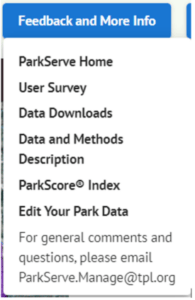Extent
The ParkServe database maintains an inventory of parks for every urban area in the U.S., including Puerto Rico. This includes all incorporated and Census-designated places that lie within any of the country’s 3,000+ census-designated urban areas. This totals to over 15,000 cities, towns, or villages included in the database, which represents about 75% of the U.S. population.
Parks Database
Trust for Public land compiled the ParkServe database from 2016 to 2018. TPL contacted each city or town to request parks data, as well as searched for GIS parks data resources on municipal and regional open data websites. If no GIS data were available, we delineated park boundaries based on satellite imagery, and confirmed public access via city park websites or signage viewable through Google Street View. Cities and towns were given the opportunity to confirm our delineated boundaries.
Today, there are about 145,000 parks in the ParkServe database. Parks data for the 100 largest cities are updated annually as part of the ParkScore Index, and parks data for all other places are updated on a monthly basis following TPL verification of public submissions via the ParkReviewer tool.
The 10-minute walk
We calculate a ten-minute walk service area for each park in the database by creating a half-mile ‘walkable’ service area from each of the park’s public access points. This service area is created using Esri’s Street Map Premium network dataset, which allows us to account for physical barriers such as highways, train tracks, or rivers without bridges.
Using these 10-minute walk service areas, we generate overall access statistics for each park, place, and urban area included in the database (e.g. number of people within a 10-minute walk of a park). This statistic is further disaggregated for three demographic variables – race/ethnicity, age, and income. In communities with an exceptionally small number of block groups, 10-minute walk demographic calculations are not available.
All calculated population statistics are based on 2023 US Census Block Group estimates provided by Esri.
Park priority areas
To help planners prioritize where to address park access gaps first, TPL provides a prioritization index for all populated areas that are not within a 10-minute walk to a park. The prioritization index is calculated for census block groups and is based on a comprehensive index of six equally weighted demographic and environmental metrics.
The six variables are calculated for each block group and normalized relative to the given city. These normalized values are then averaged to create the index value for each block group, which is then classified into the ‘very high’, ‘high’, and ‘moderate’ priority groups seen in ParkServe. The six variables are:
- Population density*
- Density of low-income households*—which are defined as households with income less than 75% of the urban area median household income
- Density of people of color*
- Community health—a combined index based on the rate of poor mental health and low physical activity from the 2023 CDC PLACES census tract dataset NOTE: These data are not available for Puerto Rico or Florida. The priority level for Puerto Rico and Florida is the average of all other variables.
- Urban heat islands—surface temperature relative to the city mean surface temperature from Trust for Public Land, based on summer 2023 Landsat 8 satellite imagery
- Pollution burden—Air toxics respiratory hazard index from 2023 EPA EJScreen
*Based on 2023 US Census Block Groups provided by Esri
EXPLORE
ParkServe’s Explore Pane hosts a suite of data to visualize contextual information about communities and their parks. Besides the parks, their 10-minute walk service areas, and the park priority areas explained above, many other layers are provided. Visualize them on the map by checking the box next to the layer name. Click on features on the map itself to learn more.
- Schools: Schoolyards across the country are a great opportunity to expand 10-minute walk park access through joint-use agreements to ensure they are open to the community after school hours. School locations from the National Center for Education Statistics 2021-2022 school year and their 10-minute walk service areas can be turned on to see how they could serve populations that currently do not have access to a park within a 10-minute walk.
- Park amenities: These crowd-sourced trails and playground data were retrieved from Open Street Map (OSM) in February of 2024 and clipped to ParkServe® park boundaries. Trail data were augmented with USGS transportation trails data from April 2024.
- ParkScore® index – park acreage equity analysis: This data layer is only available for the 100 most populous cities. It reflects the data used to calculate the ParkScore equity metric, which compares the distribution of parks and park space between neighborhoods by race and income.
- Race/Ethnicity: This layer highlights the census block groups in the highest quintile of percent people of color or percent white population, relative to the city. The metrics for people and neighborhoods of color reflect each of the Census-designated race/ethnicity groups: Black, Hispanic, Native American, Asian, Pacific Islander, two or more races, and other communities of color. All population statistics are based on US Census Block Group estimates provided by Esri.
- Income: This layer highlights the block groups in the highest quintile of percent low-income households or percent high-income households, relative to each city. Low-income households are defined as less than 75% urban area median income, high-income is defined as greater than 125% urban area median income. All population statistics are based on US Census Block Group estimates provided by Esri.
- Park acres per person: calculated based on the available park space (acres) within a half-mile buffer of each census block group divided by that block group’s population.
- Demographics: For each demographic layer, census block groups are categorized into quintiles relative to their urban area. Click the block group on the map to see specific values, including disaggregation of race/ethnicity.
- Limited English speaking (%) Percent of people in a block group living in limited English speaking households. A household in which all members age 14 years and over speak a non-English language and also speak English less than “very well” (have difficulty with English) is limited English speaking. Data source: EPA EJScreen 2023
Adults with less than high school education (%) Percent of people age 25 or older in a block group whose education is short of a high school diploma. Data source: EPA EJScreen 2023 - Population density (people per acre) Number of individuals divided by acres of the block group. Data source: Esri 2023
- Children under 19 (%) Percent of individuals under age 19. Data source: Esri 2023
- Over age 64 (%) Percent of individuals over age 64. Data source: Esri 2023
- People of color (%) Percent of individuals that identify as Black, Hispanic/Latino, Native American, Asian, Pacific Islander, multiple races, or other communities of color. Data source: Esri 2023
- Low-income households (%) Percent of households with less than 75% of the urban area median household income. Data source: Esri 2023
- Limited English speaking (%) Percent of people in a block group living in limited English speaking households. A household in which all members age 14 years and over speak a non-English language and also speak English less than “very well” (have difficulty with English) is limited English speaking. Data source: EPA EJScreen 2023
- Health: the 2023 CDC PLACES dataset by census tract is used to show the prevalence of the two metrics described below, with values shown relative to the urban area. CDC PLACES data are not available for Puerto Rico.
- Poor mental health: Respondents aged ≥18 years who report 14 or more days during the past 30 days during which their mental health was not good.
- Lack of physical activity: Respondents aged ≥18 who answered “no” to the following question: “During the past month, other than your regular job, did you participate in any physical activities or exercises such as running, calisthenics, golf, gardening, or walking for exercise”
- Climate:
- Urban Heat Islands: Trust for Public Land’s 2023 Urban Heat Island dataset shows where Landsat 8 satellite imagery thermal reflectance values are hotter than the average of the whole boundary
- City – shows land surface temperature relative to the city boundary
- Urban area – shows land surface temperature relative to the urban area boundary
- Pollution burden: EPA EJScreen NATA respiratory hazard index metric is based on the 2017 National Air Toxics Assessment
- Heat-risk priority zones: areas where urban heat islands coincide with high density of people outside a 10-minute walk of a park. For each city, the park priority area block groups that are in the top two quintiles for heat AND the top two quintiles for population density were extracted, then merged into contiguous areas. The top five of these areas with the highest population are labeled on the map, indicating where many people live without park access and are exposed to relatively high land surface temperatures.
- Urban Heat Islands: Trust for Public Land’s 2023 Urban Heat Island dataset shows where Landsat 8 satellite imagery thermal reflectance values are hotter than the average of the whole boundary
PRIORITIZE
ParkServe’s Prioritize Pane allows users to create their custom park prioritization index based on the same variables included in the default Park Priority Areas.
To customize the weighting of the variables, move each variable’s slider left to reduce the weight or to the right to increase its weighting. To only look at a single variable, move all other variables to the far left except for the variable of interest. The default view masks the priority areas with existing parks and their service areas. To see the custom prioritization index for the entire city, regardless of existing park access, toggle the orange dial at the bottom of the page. NOTE: Health data are not available for Puerto Rico and therefore the slider bars for Mental Health and Physical Inactivty do not affect the map in Puerto Rico.
Return to the EXPLORE tab to visualize your Custom Prioritization layer alongside all the other layers in the map.
EVALUATE
The ParkEvaluator™ tool allows users to evaluate the impact of proposed parks and/or trails on 10-minute walk statistics. Once the parks or trails are added, patience is needed for the ParkEvaluator to complete the analysis. This could take up to five or ten minutes to run depending on how many features were drawn on the map.
When the run is completed, the 10-Minute Walk Statistics pane is updated with statistics about how the new features would impact the city’s overall 10-minute walk access statistics, broken down by age, race/ethnicity, and income. Click the blue Export Report button to get this information via a downloadable pdf report.
Other:
In order to accurately represent park access across large communities, open public access is the key criteria for inclusion in our database. We include a wide variety of parks, trails, and open space, so long as there is no barrier to entry.
Examples of parks we include:
• Publicly-owned local, state, and national parks, trails, and open space
• School with a joint-use agreement with the local government.
• Privately-owned parks that are managed for full public use
Examples of parks we don’t include:
• Parks in gated communities
• Private golf courses
• Private cemeteries
• School parks/playgrounds without active joint-use agreements
• Zoos, museums, professional sports stadiums
The big blue “Feedback and More Info” button on the upper right-hand side of the mapping application will direct you to provide feedback on park data:

By clicking on “Edit Your Park Data”, you will be directed to a mapping application, the ParkReviewer™. Here you can submit edits to us directly, and after a review by our team, they will be published to the ParkServe platform. Details on using the ParkReviewer can be found in the help menu in the upper right corner of the ParkReviewer application.
Alternatively, you can email a shapefile or feature class to [email protected].

